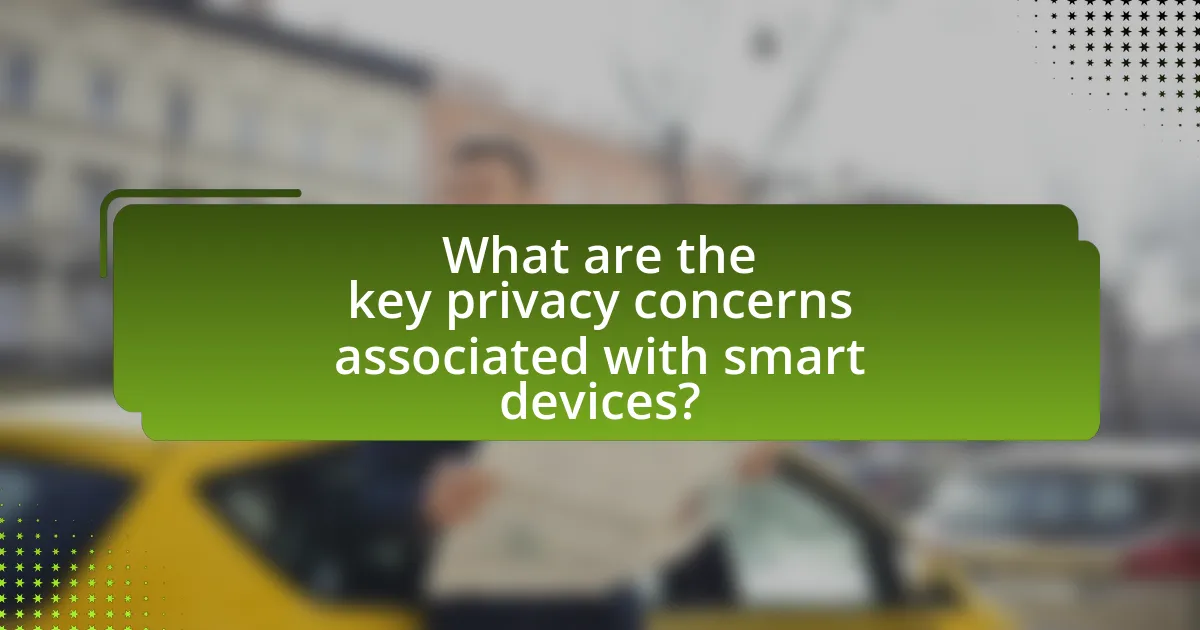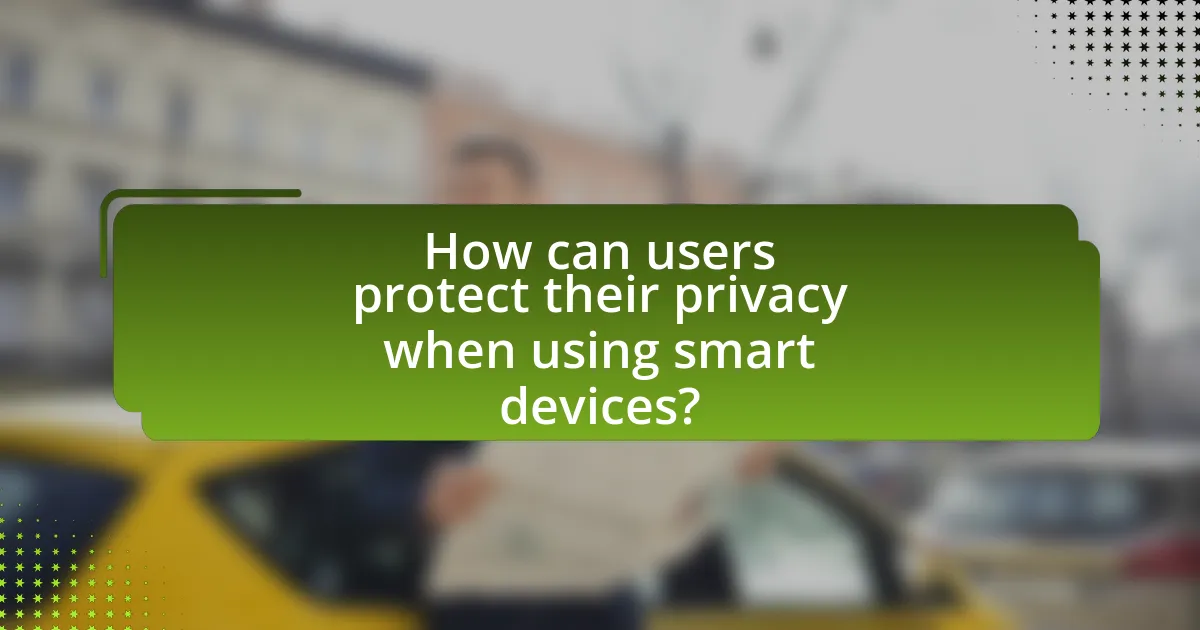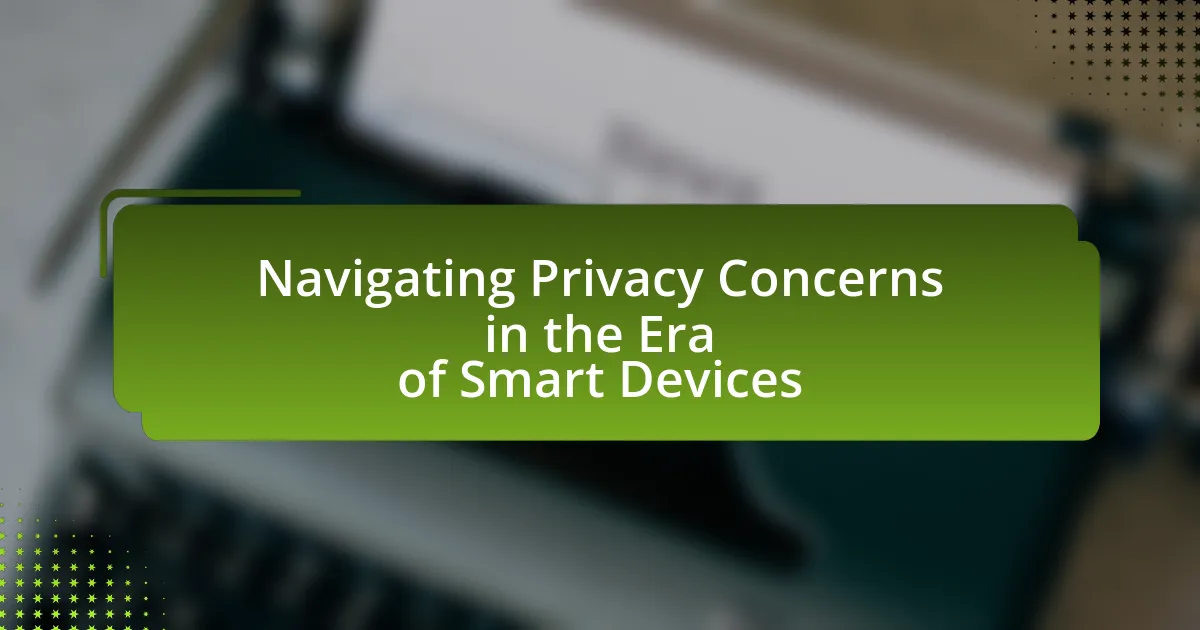The article focuses on the critical privacy concerns associated with smart devices, highlighting issues such as data collection, unauthorized access, and insufficient user control over personal information. It examines how smart devices gather various types of data, including location, usage patterns, and health metrics, and discusses the implications of data breaches and the importance of user consent. Additionally, the article outlines practical steps users can take to protect their privacy, including managing privacy settings, utilizing security tools, and staying informed about privacy regulations. It also explores future trends in privacy protection and the evolving role of technology and regulations in safeguarding user data.

What are the key privacy concerns associated with smart devices?
Key privacy concerns associated with smart devices include data collection, unauthorized access, and lack of user control. Smart devices often collect vast amounts of personal data, including location, usage patterns, and even conversations, which can be exploited if not properly secured. Unauthorized access can occur through hacking or inadequate security measures, leading to potential breaches of sensitive information. Furthermore, many smart devices do not provide users with sufficient control over their data, making it difficult for individuals to manage their privacy settings effectively. According to a 2021 report by the Electronic Frontier Foundation, many popular smart devices have been found to transmit data without user consent, highlighting the urgent need for improved privacy protections.
How do smart devices collect personal data?
Smart devices collect personal data through various methods, including sensors, internet connectivity, and user interactions. These devices utilize built-in sensors such as cameras, microphones, and GPS to gather information about users’ behaviors and preferences. For instance, smart speakers record voice commands to improve user experience and provide personalized responses. Additionally, data is transmitted over the internet to cloud services, where it is processed and analyzed, often leading to targeted advertising or service enhancements. According to a 2021 report by the Pew Research Center, 81% of Americans feel they have little to no control over the data collected about them by these devices, highlighting the pervasive nature of data collection in smart technology.
What types of data are commonly collected by smart devices?
Smart devices commonly collect various types of data, including personal information, location data, usage patterns, health metrics, and environmental data. Personal information may encompass user profiles, preferences, and contact details, while location data tracks the device’s geographical position. Usage patterns involve how users interact with the device, such as frequency and duration of use. Health metrics can include heart rate, sleep patterns, and physical activity levels, particularly in wearables. Environmental data may consist of temperature, humidity, and air quality measurements, which smart home devices often monitor. These data types are essential for enhancing user experience and functionality but raise significant privacy concerns.
How is this data used by manufacturers and third parties?
Manufacturers and third parties use data collected from smart devices to enhance product development, improve user experience, and target marketing efforts. This data allows manufacturers to analyze user behavior, identify trends, and make informed decisions about product features and improvements. For instance, a study by the International Data Corporation found that 80% of manufacturers leverage user data to refine their offerings and increase customer satisfaction. Third parties, such as advertisers, utilize this data to create personalized marketing campaigns, ensuring that advertisements are relevant to specific user demographics and preferences. This targeted approach can lead to higher engagement rates and increased sales, demonstrating the significant role that data plays in the strategies of both manufacturers and third parties.
What risks do smart devices pose to user privacy?
Smart devices pose significant risks to user privacy primarily through data collection, unauthorized access, and potential surveillance. These devices often collect personal information, including location data, usage patterns, and voice recordings, which can be exploited if not properly secured. For instance, a study by the Electronic Frontier Foundation found that many smart home devices transmit data without adequate encryption, making them vulnerable to hacking. Additionally, manufacturers may share user data with third parties, leading to further privacy breaches. The combination of these factors creates an environment where user privacy is at risk, highlighting the need for robust security measures and user awareness.
How can unauthorized access to smart devices compromise privacy?
Unauthorized access to smart devices can compromise privacy by allowing intruders to access personal data, monitor activities, and control device functions. For instance, hackers can exploit vulnerabilities in smart home systems to gain entry into private networks, leading to unauthorized surveillance through cameras or microphones. A study by the Ponemon Institute found that 63% of organizations experienced a data breach due to unsecured IoT devices, highlighting the significant risk posed by inadequate security measures. This unauthorized access can result in identity theft, financial loss, and the exposure of sensitive information, thereby severely undermining individual privacy.
What are the implications of data breaches involving smart devices?
Data breaches involving smart devices can lead to significant privacy violations and security risks for users. These breaches often result in unauthorized access to personal data, including sensitive information such as health records, financial details, and location data. For instance, a 2020 report by the Identity Theft Resource Center indicated that data breaches in the Internet of Things (IoT) sector increased by 50% compared to the previous year, highlighting the growing vulnerability of smart devices. Additionally, compromised devices can be exploited for further attacks, such as botnets, which can disrupt services and compromise additional systems. The implications extend beyond individual users, affecting companies’ reputations and leading to potential legal consequences, as seen in cases where organizations faced lawsuits for failing to protect user data adequately.
Why is user consent important in the context of smart devices?
User consent is crucial in the context of smart devices because it empowers individuals to control their personal data and privacy. Smart devices often collect sensitive information, such as location, health data, and usage patterns, which can be misused if shared without explicit permission. According to a 2020 survey by the Pew Research Center, 79% of Americans expressed concern about how their data is being used by companies, highlighting the need for transparency and user agency. Consent ensures that users are informed about data collection practices and can make choices that align with their privacy preferences, thereby fostering trust between users and technology providers.
How do privacy policies affect user consent?
Privacy policies significantly influence user consent by outlining how personal data is collected, used, and shared. These documents serve as a legal framework that informs users about their rights and the implications of their data usage, thereby enabling informed decision-making. For instance, the General Data Protection Regulation (GDPR) mandates that organizations must obtain explicit consent from users before processing their personal data, emphasizing transparency and user control. This regulatory requirement illustrates how privacy policies not only inform users but also establish the conditions under which consent is granted, ensuring that users are aware of their choices and the potential risks involved.
What challenges exist in obtaining informed consent from users?
Obtaining informed consent from users presents several challenges, primarily due to the complexity of information and varying levels of user understanding. Users often encounter lengthy and technical privacy policies that are difficult to comprehend, leading to confusion about what they are consenting to. A study by the Pew Research Center found that 79% of Americans are concerned about how their data is being used by companies, indicating a general distrust that complicates the consent process. Additionally, the rapid evolution of technology means that users may not fully grasp the implications of their consent in relation to future data usage, creating a gap in informed decision-making. These factors collectively hinder the effectiveness of obtaining genuine informed consent from users.

How can users protect their privacy when using smart devices?
Users can protect their privacy when using smart devices by implementing strong security measures, such as enabling two-factor authentication and regularly updating device firmware. These actions significantly reduce the risk of unauthorized access, as two-factor authentication adds an extra layer of security beyond just a password, and firmware updates often include critical security patches that address vulnerabilities. According to a report by the Cybersecurity & Infrastructure Security Agency, keeping software up to date is one of the most effective ways to safeguard against cyber threats. Additionally, users should review and adjust privacy settings on their devices to limit data sharing and disable unnecessary features that may compromise their privacy.
What steps can users take to secure their smart devices?
To secure their smart devices, users should implement strong, unique passwords for each device and enable two-factor authentication whenever possible. Strong passwords reduce the risk of unauthorized access, while two-factor authentication adds an extra layer of security by requiring a second form of verification. Additionally, users should regularly update their device firmware and software to protect against vulnerabilities, as manufacturers often release updates to address security flaws. Furthermore, disabling unnecessary features, such as remote access or location tracking, can minimize exposure to potential threats. According to a 2021 report by the Cybersecurity & Infrastructure Security Agency, 85% of successful cyberattacks exploit known vulnerabilities, highlighting the importance of timely updates and security measures.
How can users manage privacy settings on their devices?
Users can manage privacy settings on their devices by accessing the settings menu specific to their operating system. For example, on Android devices, users navigate to Settings, then Privacy, where they can adjust permissions for apps, location services, and data sharing. On iOS devices, users go to Settings, then Privacy, allowing them to control app permissions, tracking, and advertising preferences. These settings enable users to limit data collection and enhance their privacy. According to a 2021 survey by Pew Research Center, 81% of Americans feel they have little to no control over the data collected by companies, highlighting the importance of actively managing these settings to protect personal information.
What role does software updates play in device security?
Software updates play a critical role in device security by patching vulnerabilities that could be exploited by cybercriminals. These updates often include fixes for security flaws identified in the software, which, if left unaddressed, can lead to unauthorized access, data breaches, and other malicious activities. For instance, a report from the Cybersecurity and Infrastructure Security Agency (CISA) indicates that 85% of successful cyberattacks exploit known vulnerabilities for which patches are available. Regularly applying software updates ensures that devices are equipped with the latest security measures, thereby significantly reducing the risk of compromise.
What tools and resources are available for privacy protection?
Various tools and resources are available for privacy protection, including VPNs, encryption software, privacy-focused browsers, and secure messaging apps. VPNs, such as NordVPN and ExpressVPN, encrypt internet traffic, making it difficult for third parties to track online activities. Encryption software like VeraCrypt secures files and data, while privacy-focused browsers such as Brave and Firefox offer enhanced tracking protection. Secure messaging apps like Signal and Telegram provide end-to-end encryption, ensuring that communications remain private. These tools collectively help individuals safeguard their personal information against unauthorized access and surveillance.
How can users utilize VPNs and firewalls to enhance privacy?
Users can utilize VPNs and firewalls to enhance privacy by encrypting their internet traffic and blocking unauthorized access to their devices. VPNs create a secure tunnel for data transmission, making it difficult for third parties to intercept or monitor online activities. For instance, a study by the Electronic Frontier Foundation highlights that VPNs can prevent ISPs from tracking user behavior and selling data. Firewalls, on the other hand, act as barriers that filter incoming and outgoing traffic, protecting devices from malicious attacks and unauthorized access. According to the Cybersecurity & Infrastructure Security Agency, properly configured firewalls can significantly reduce the risk of data breaches, thereby enhancing overall privacy.
What are the benefits of using privacy-focused applications?
Privacy-focused applications enhance user security by minimizing data collection and protecting personal information. These applications often employ end-to-end encryption, ensuring that only the intended recipients can access the data, which significantly reduces the risk of unauthorized access. For instance, a study by the Electronic Frontier Foundation highlights that privacy-focused messaging apps, like Signal, utilize strong encryption protocols, making it difficult for third parties to intercept communications. Additionally, these applications typically offer features that allow users to control their data, such as customizable privacy settings and the ability to delete data permanently. This empowers users to maintain their digital autonomy and reduces the likelihood of data misuse by corporations or malicious actors.
Why is it important to stay informed about privacy issues?
Staying informed about privacy issues is crucial because it empowers individuals to protect their personal information from misuse. In an era where smart devices collect vast amounts of data, understanding privacy risks helps users make informed decisions about their digital interactions. For instance, a 2021 survey by the Pew Research Center found that 81% of Americans feel they have little to no control over the data collected about them, highlighting the need for awareness and proactive measures. By being informed, individuals can advocate for stronger privacy protections and choose technologies that prioritize their security.
How can users keep up with changes in privacy regulations?
Users can keep up with changes in privacy regulations by regularly following updates from authoritative sources such as government websites, legal blogs, and privacy advocacy organizations. These sources often publish timely information regarding new laws and amendments, ensuring users are informed about their rights and obligations. For instance, the European Union’s General Data Protection Regulation (GDPR) has set a precedent for privacy laws globally, and updates related to it can be tracked through the European Commission’s official site. Additionally, subscribing to newsletters from privacy-focused organizations like the Electronic Frontier Foundation (EFF) can provide users with curated insights and analyses on emerging regulations.
What resources are available for educating users about privacy risks?
Resources available for educating users about privacy risks include government websites, non-profit organizations, and online courses. Government websites like the Federal Trade Commission (FTC) provide guidelines and tips on protecting personal information. Non-profit organizations such as the Electronic Frontier Foundation (EFF) offer comprehensive resources and articles on digital privacy. Additionally, platforms like Coursera and edX offer online courses focused on data privacy and security, helping users understand the implications of their digital actions. These resources are validated by their widespread use and recognition in the field of privacy education.

What are the future trends in privacy and smart devices?
Future trends in privacy and smart devices include increased user control over personal data, enhanced encryption methods, and the integration of artificial intelligence for privacy protection. As consumers become more aware of privacy issues, companies are likely to adopt transparent data practices, allowing users to manage their data preferences more effectively. For instance, the implementation of privacy-by-design principles in device development is expected to become standard, ensuring that privacy features are built into products from the outset. Additionally, advancements in AI will enable smarter data anonymization techniques, reducing the risk of personal information exposure. According to a report by Gartner, by 2025, 75% of the global population will have its personal data covered under modern privacy regulations, highlighting the growing emphasis on privacy in the smart device market.
How is technology evolving to address privacy concerns?
Technology is evolving to address privacy concerns through enhanced encryption methods, decentralized data storage, and the implementation of privacy-focused regulations. For instance, end-to-end encryption is increasingly used in messaging applications, ensuring that only the communicating users can read the messages, thereby protecting user data from unauthorized access. Additionally, decentralized data storage solutions, such as blockchain technology, allow users to control their own data without relying on centralized servers, reducing the risk of data breaches. Furthermore, regulations like the General Data Protection Regulation (GDPR) in Europe mandate strict data protection measures, compelling companies to prioritize user privacy and transparency. These advancements collectively contribute to a more secure digital environment, addressing the growing concerns surrounding personal privacy in the age of smart devices.
What advancements are being made in data encryption for smart devices?
Advancements in data encryption for smart devices include the implementation of end-to-end encryption, which ensures that data is encrypted on the sender’s device and only decrypted on the recipient’s device, preventing unauthorized access during transmission. Additionally, the adoption of quantum encryption techniques is emerging, utilizing the principles of quantum mechanics to create secure communication channels that are theoretically immune to eavesdropping. Furthermore, the integration of hardware-based security modules, such as Trusted Platform Modules (TPMs), enhances encryption by securely storing cryptographic keys and performing encryption tasks within a protected environment. These advancements are supported by industry standards and protocols, such as the Internet Engineering Task Force’s (IETF) TLS 1.3, which improves security and performance for encrypted communications.
How are companies implementing privacy by design in new products?
Companies are implementing privacy by design in new products by integrating data protection measures throughout the product development lifecycle. This approach includes conducting privacy impact assessments during the design phase, ensuring that data minimization principles are applied, and incorporating user consent mechanisms directly into the user interface. For instance, organizations like Apple and Microsoft have adopted privacy by design frameworks that prioritize user data security, as evidenced by Apple’s App Tracking Transparency feature, which requires apps to obtain explicit user permission before tracking their data. This proactive stance not only complies with regulations like the GDPR but also builds consumer trust, as demonstrated by a 2021 survey indicating that 79% of consumers are more likely to engage with brands that prioritize their privacy.
What role do regulations play in shaping the future of smart device privacy?
Regulations play a critical role in shaping the future of smart device privacy by establishing legal frameworks that govern data collection, usage, and protection. These regulations, such as the General Data Protection Regulation (GDPR) in Europe, mandate that companies obtain explicit consent from users before collecting personal data, thereby enhancing user control over their information. Furthermore, regulations often require transparency in data practices, compelling companies to disclose how data is used and shared, which fosters trust among consumers. The enforcement of penalties for non-compliance also incentivizes companies to prioritize privacy, leading to the development of more secure smart devices. As smart technology continues to evolve, ongoing regulatory adaptations will be essential to address emerging privacy challenges and ensure that user rights are upheld.
How are governments responding to privacy concerns in the tech industry?
Governments are responding to privacy concerns in the tech industry by implementing stricter regulations and enhancing data protection laws. For instance, the European Union’s General Data Protection Regulation (GDPR), enacted in 2018, imposes significant penalties on companies that fail to protect user data, thereby setting a global standard for privacy. Additionally, various countries are enacting their own privacy laws, such as California’s Consumer Privacy Act (CCPA), which grants consumers more control over their personal information. These legislative measures reflect a growing recognition of the need to safeguard individual privacy in an increasingly digital world.
What impact do global privacy laws have on smart device manufacturers?
Global privacy laws significantly impact smart device manufacturers by imposing stringent regulations on data collection, storage, and usage practices. These laws, such as the General Data Protection Regulation (GDPR) in Europe and the California Consumer Privacy Act (CCPA) in the United States, require manufacturers to implement robust data protection measures, obtain explicit user consent, and ensure transparency in their data handling processes. Compliance with these regulations often necessitates substantial investments in technology and legal resources, which can increase operational costs for manufacturers. Additionally, failure to comply can result in severe penalties, including fines that can reach millions of dollars, thereby influencing manufacturers to prioritize privacy in their product development and marketing strategies.
What practical tips can users follow to navigate privacy concerns effectively?
Users can navigate privacy concerns effectively by implementing strong password practices, utilizing two-factor authentication, and regularly reviewing privacy settings on devices and applications. Strong passwords, which include a mix of letters, numbers, and symbols, significantly reduce the risk of unauthorized access; a study by the National Institute of Standards and Technology found that 81% of data breaches are linked to weak passwords. Two-factor authentication adds an extra layer of security, making it harder for attackers to gain access even if they have the password. Regularly reviewing privacy settings allows users to control what data is shared and with whom, ensuring that personal information is protected.



